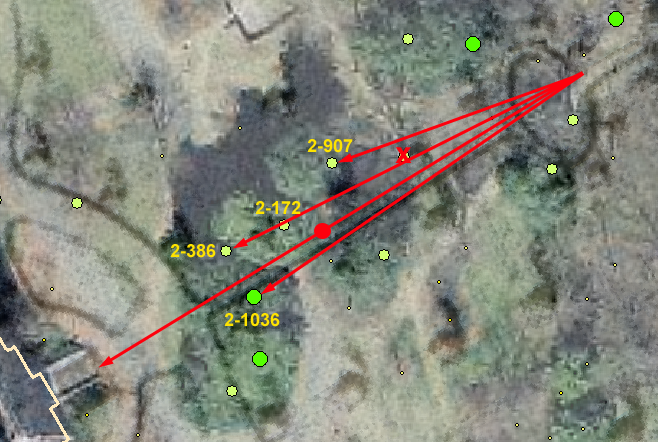Kirkland Hall’s Big Trees
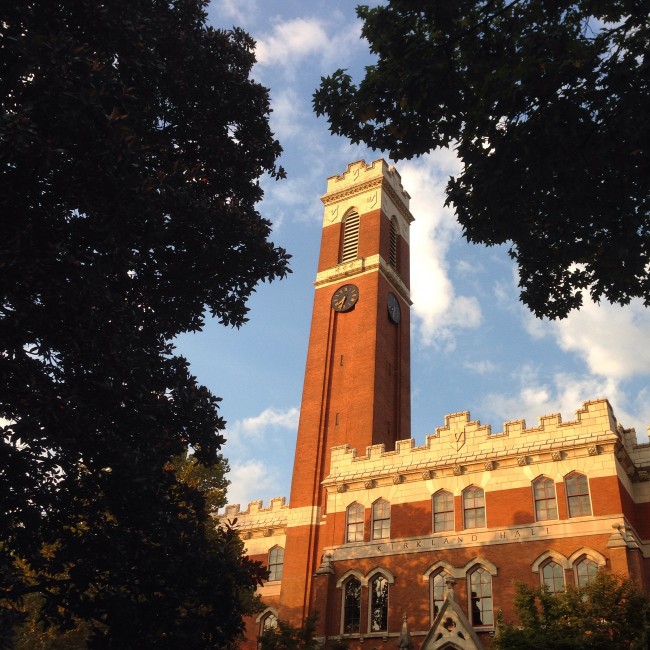
Kirkland Hall is the historic and administrative center of Vanderbilt University. Built in 1875, it was the first building constructed on campus after the founding of the university. It is the probably the most photographed building on campus and is often one of the first buildings seen by visitors to campus. After the large clock tower, one of the most striking features of the environs of Kirkland Hall are the large trees that surround the building. In particular, the huge southern magnolias that stand opposite the front steps of the building have been a landmark for over a hundred years.
In this blog post, I want to highlight some of the significant trees that are on the east side of the building, facing its front. In a previous post, I have already mentioned Galloway’s ginkgo, which grows on the north side of Kirkland Hall, between it and West End Avenue. I will discuss some of the trees south of the building in a future blog post.
Kirkland Hall’s magnificent magnolias
During the past several years, I have been trying to document the largest and oldest trees in the arboretum. Initially, I was focused primarily on oaks, because they top the list of biggest trees. They are also relatively easy to measure because they usually have a single straight trunk, making it easy to compare their height, diameter at breast height, and crown spread (the three characteristics used to score “champion” trees). More recently, I’ve turned my attention to the large southern magnolias (Magnolia grandiflora) that are a well-known feature of the Vanderbilt campus.

Magnolias are a tougher to rate than oaks. They often have trunks that split near the ground, and two trees that are nearly identical in size can get drastically different scores if one splits just above breast height (resulting in an extra-large diameter measurement) and the other splits below breast height (only the one largest stem above breast height counts in the score). They can also vary in overall shape, with some being relatively narrow and tall, and with others that are about the same overall volume being very broad, but less tall. To further complicate matters, some (notably the big one in the southeast corner of Library Lawn) have drooping branches that have rooted and become clones that are themselves tree-sized.
Over the past six months, I’ve spent a fair amount of time measuring and pondering the big magnolias on campus and have tried to understand what kind of size is required for a southern magnolia to be really ancient. This has required some detective work in the University Archives and I’ve already written some on this subject in a recent post about the big magnolias on Magnolia Lawn. In this post, I will talk about what I’ve learned about the big magnolias east of Kirkland. In particular, I wanted to know which of them were likely to be over 100 years old, and whether any of were candidates to be “McTyeire legacy trees” (i.e. among the 1500 trees planted by Bishop Holland McTyeire during the first few years of the university).
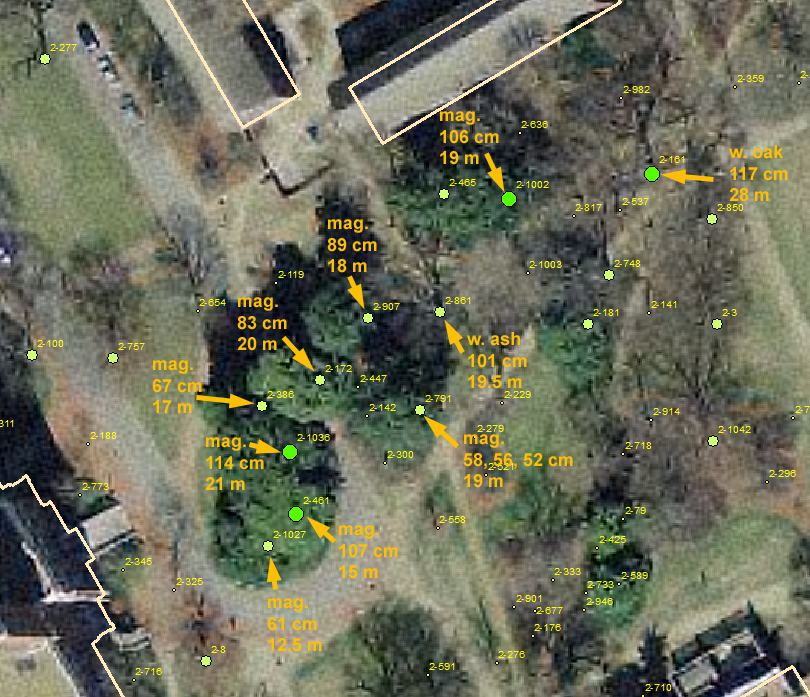
The aerial photo above shows most of the largest trees east of Kirkland Hall. As you can see, many of them are magnolias. The white ash 2-861 was until recently on the list of the largest 50 trees on campus. Unfortunately, in September 2014 it was so badly damaged in a storm that it had to be removed. The center of the trunk was rotted, so I couldn’t get an exact age by counting trunk rings, but I counted the rings on a cross section of one of its largest branches and found that the branch was 90 years old. This branch was high enough on the tree that the tree was probably at least 10 years old when it formed, so that would put its age at right around 100 years when it died, and would place its planting date at about 1915. I will talk about the other non-magnolia on this map, white oak 2-161, at the end of this post.
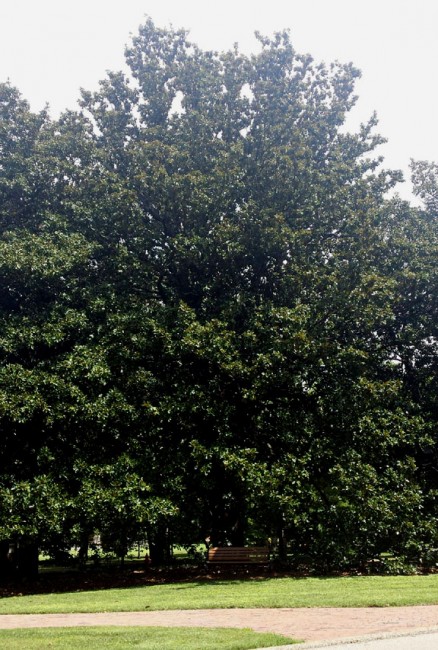
Of the eight magnolias shown on the map above, which are the really big ones? As you might guess from what I said earlier, that answer is not as simple as it might seem. At 114 cm diameter and a 21 m height, magnolia 2-1036 is clearly the largest of the group and is tied for the position of 4th largest magnolia in the arboretum. 2-461 and 2-1002 both have diameters of over 100 cm, but these figures are somewhat inflated since they are measured at a height that is just below a trunk split where the trunk is extra wide. In contrast 2-791 has an official diameter of only 58 cm, but its trunk splits three ways just below breast height and 58 cm is only the diameter of the biggest of the three stems. Overall, it’s actually one of the larger trees. Height seems to be a better indicator of overall size here: the five magnolias that are estimated to have heights of 18 or more meters (2-1036, 2-172, 2-791, 2-907, and 2-1002) do appear from visual inspection to be the biggest.
How old are the Kirkland magnolias?
One would expect that the largest magnolias would also be the oldest. Because of the problems associated with getting a consistent measure of size, it’s helpful to have some actual hard data about age, rather than depending solely on size as an indication of age. Fortunately, there are two really good historical aerial photos of the part of campus near Kirkland. For comparison purposes, I’ll start off the time series of images with an unannotated version of the 2010 photo.

Here is the same area on a georectified version of the 1958 aerial photo:
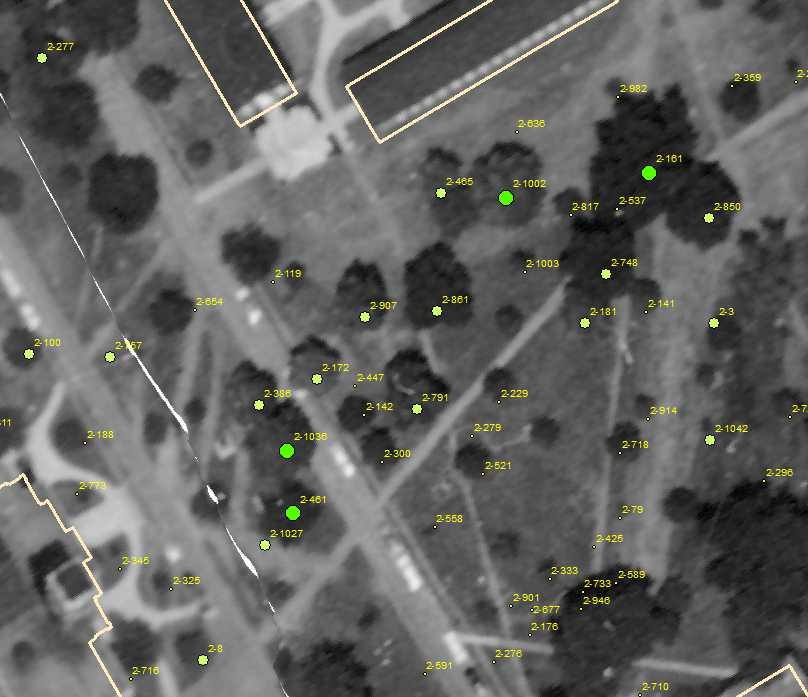
We can see that magnolia 2-1027 has dropped out of the picture. The rest are all still there. Notice that the Cornelius Vanderbilt statue is in front of the steps in the center of the loop drive, rather than near the entrance as it is today. Here is a photo from around 1948:

This photo was taken from a more oblique angle, so we can get a better sense of the height of the trees. The Cornelius Vanderbilt statue is closer to the base of the steps than in 1958, and the original circular drive that went all the way around Kirkland Hall is in place. We see in this image that magnolia 2-461 has disappeared. The magnolias that were the five largest in 2010 are all present in the 1948 photo and it appears that 2-386 is also there, although it’s a bit obscured by being behind 2-1036. Although there is some variation in shape and height, the 2010 big five appear to all be approximately the same size in 1948, although it is hard to see 2-172 because it is mostly in shadow.
So this photo confirms that the five trees that were 18 or more meters tall in 2010 were already large trees by 1948. If we assume that they were at least 30 years old at that time (which seems likely given their size), we can assume that they are at least 100 years old today. But how much older than that? Unfortunately, the aerial photos of campus that I’ve seen which are earlier than 1948 doe not show this part of campus clearly.
The pond and the path from Kirkland to 21st Avenue
As luck would have it, my friends in the Vanderbilt Special Collections and University Archives came through for me again. They helped me find a most excellent image that shows a view of the front of Kirkland Hall in its early days.
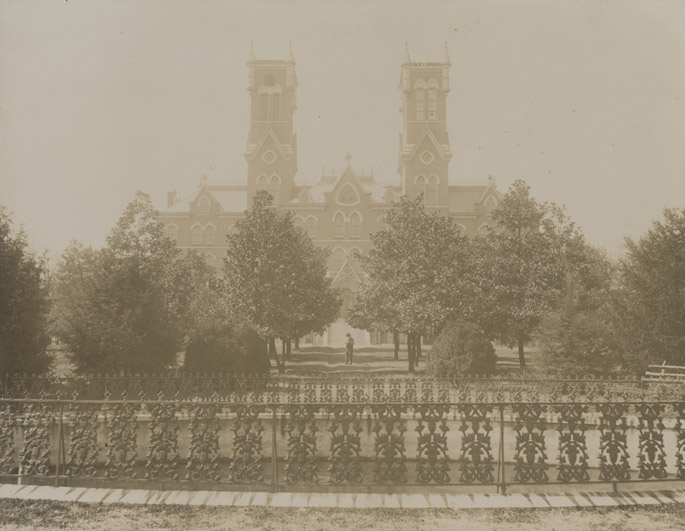
There are several interesting things to notice about this photo. The most obvious is that Kirkland Hall (called “Old Main” at the time) has two towers. This was the state of the building until the fire in 1905 that destroyed the interior of the building. Another significant (if less noticeable) aspect of the image is that there is no statue of Cornelius Vanderbilt in front of the steps. That statue is noticeable at various positions in the 1948 and 1959 images. The statue was created for the Tennessee Centennial Exhibition in 1897, where it stood in front of the west entrance of the Parthenon. At the close of the exhibition, the statue was moved in front of Kirkland Hall. So although we can’t know the date of this photo for sure, due to the absence of the statue, we can know that it was taken some time before 1897. Of course, I was most excited by the rows of trees on either side of the path leading from the pond to the front steps. Based on the size and shininess of their leaves, the trees appear to be southern magnolias! It seems likely that some of them are the same trees that still stand near Kirkland.
When I first saw the photo, I was confused about the fence in the foreground. At first I thought it went along the side of some road or path. After some investigation, I realized that it was surrounding an ornamental pond. In a somewhat fanciful drawing of the early campus, the pond is shown as having a fountain in it:
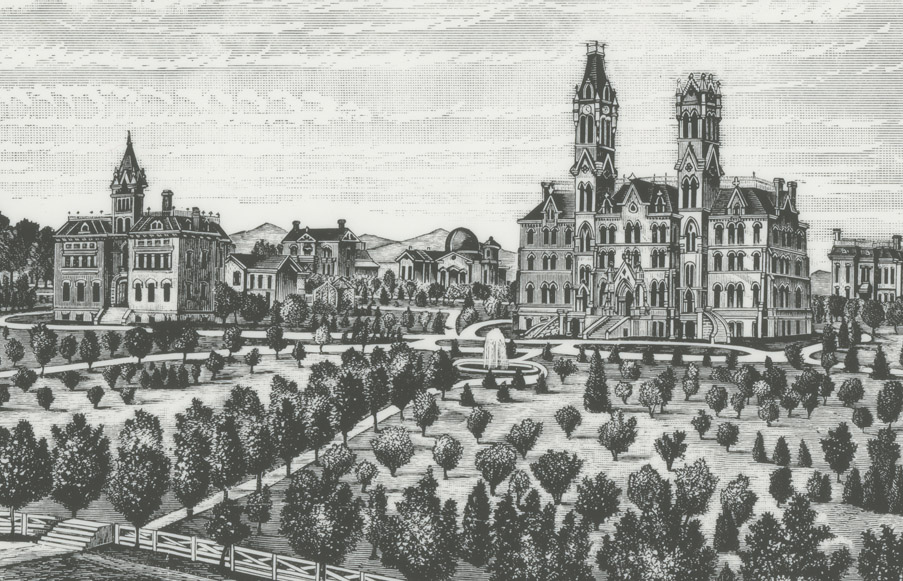
I can’t really see any evidence of the plumbing associated with a fountain in the pre-1897 photo, so it isn’t clear to me if, when, or for how long, the fountain functioned in the pond. This drawing also shows clearly that a path led from the front steps of Kirkland, around the pond, and then straight to 21st Avenue. South, where a stile allowed pedestrians, but not cows, to cross over the fence that surrounded the campus.
A bit of luck (and Googling) came up with another view looking across the pond towards Kirkland. I found the photo on Pinterest, so I don’t know anything about its origin or date.
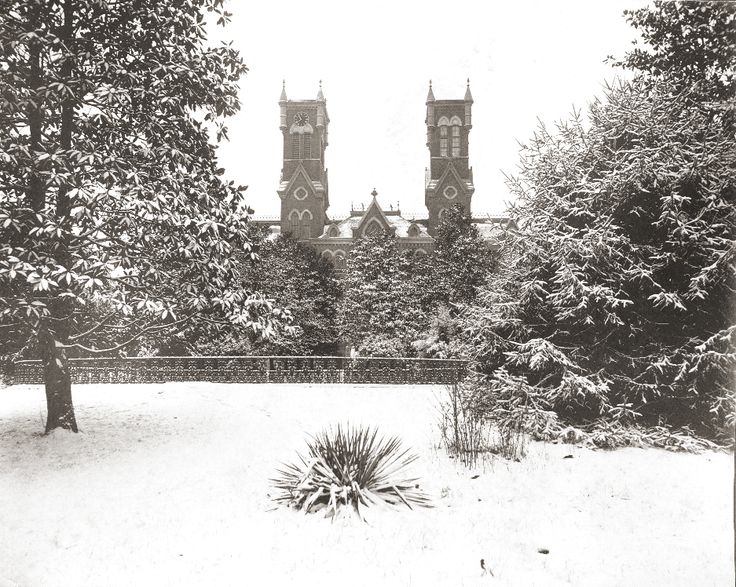
It appears that this photo was taken about the same time as the other pre-1897 photo – the same bushes are visible between the pond and the magnolias and the magnolias look approximately the same size.
In order to get better information about the location of the magnolia trees, I needed to know as exactly as possible where the pond was located. I looked at a copy of a map of campus from about 1897 that I had gotten from the archives, and noticed that it showed the location of the pond:
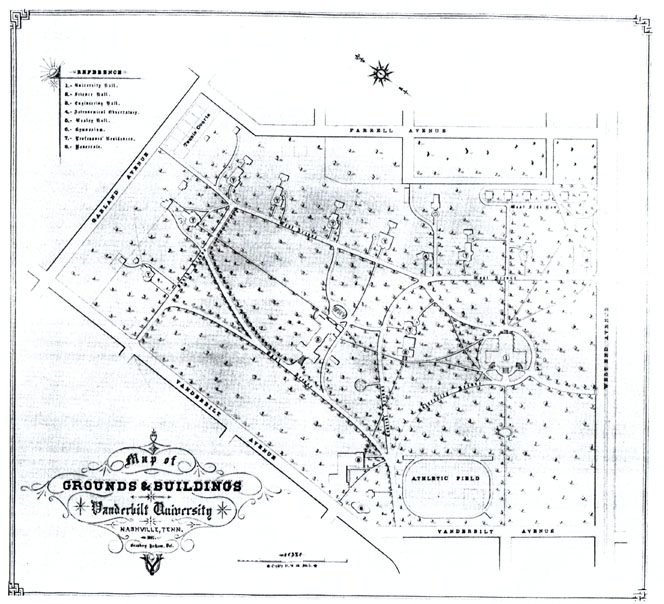
I wasn’t sure how accurate this map was, but when I georectified it as a GIS layer, the features shown on the map fit fairly precisely. Here is a portion of the 2010 aerial with the 1897 map overlaid:
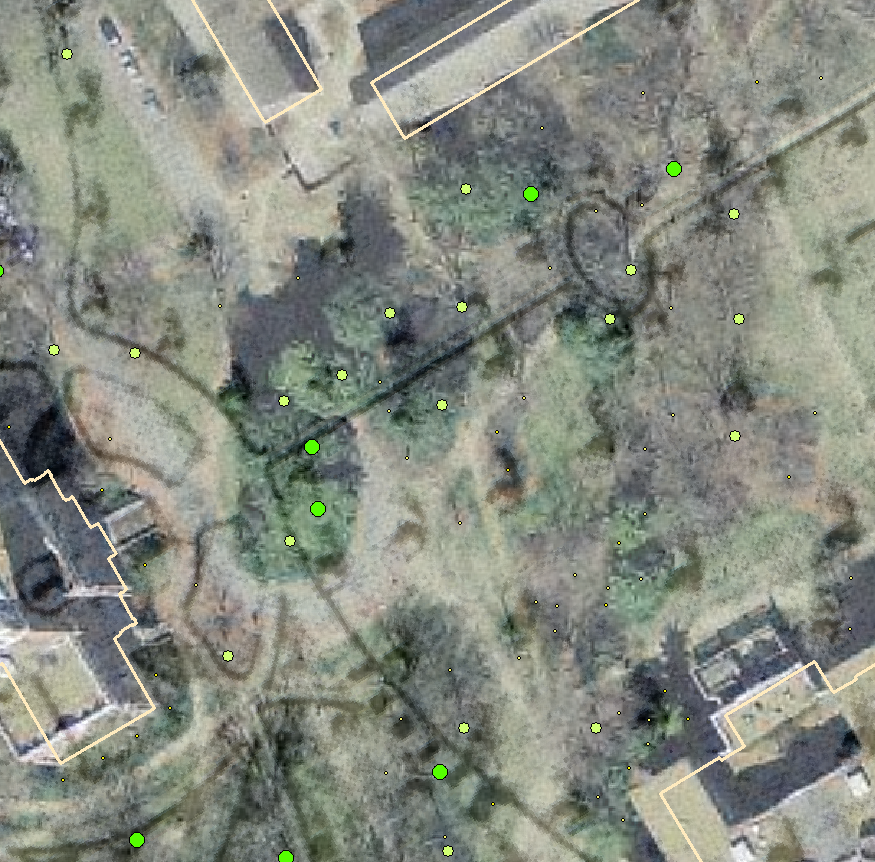
We can see at the upper right that a portion of the walk that leads from Kirkland to Wilson Hall follows exactly the old path from Kirkland to 21st Avenue. The edge of the pond, where the pre-1897 photo was taken, is just where the sidewalk makes an angled turn towards the south and veers off from the line that leads directly to the front steps of Kirkland. Unfortunately, the 2010 aerial photo shows the old Kissam Quad buildings, the current location of the new Warren and Moore residential colleges. So although you can’t tell from this photo, the bend in the sidewalk is near the gap between Warren and Moore. There is also a trash can and a lamp post near the bend if you want to try to locate for yourself the spot where the pre-1897 photo was taken.
Time for the nerdy analysis
If you have been following this blog for a while, you know that I can’t resist doing a nerdy spatial analysis of old historical photos to try to discover more about the trees that are depicted in them. This post is no exception. If the calculations cause you to zone out, you can just look at the pictures and skip to the conclusions at the end of this section.
Once I knew exactly where the photo was taken, I wanted to try to recreate it at the present time. Here is my attempt:
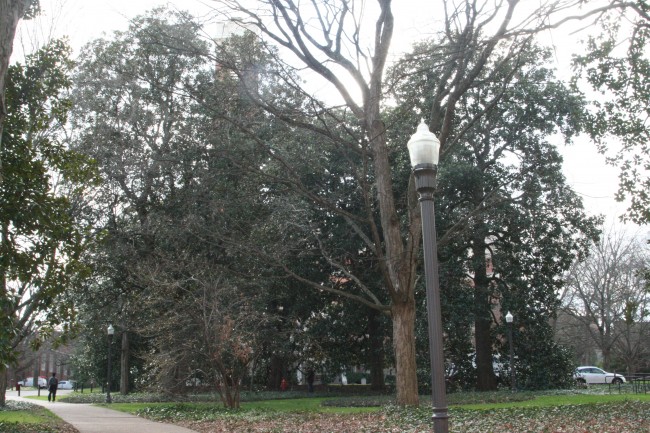
It is difficult to recognize this is the same location as in the pre-1897 photo. The sidewalk has changed directions, the pond is gone, and the magnolias (presuming that they are the same ones) are much larger and make it difficult to see Kirkland Hall. Nevertheless, the left tower is just barely visible, and the front stairs can be seen through the lower branches. And can that be a student reading a book between us and the stairs?!
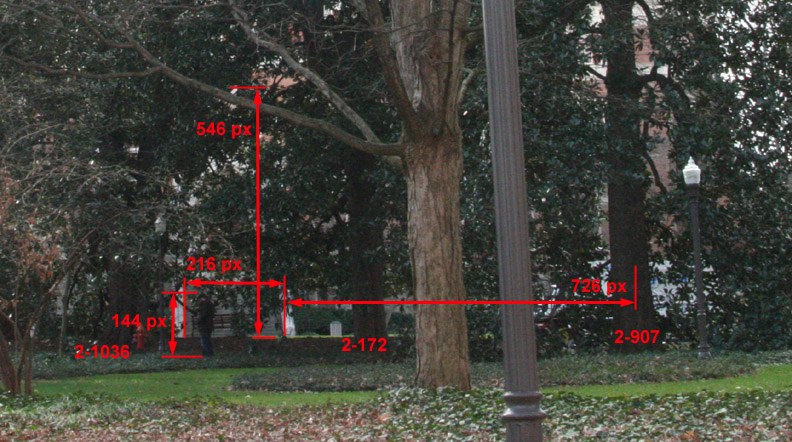
Actually, that’s my colleague Jordan Utley, who agreed to be in the photo for scale. And I think he’s checking his phone rather than reading a book. Whatever… For comparison purposes, here’s the same view before 1897:
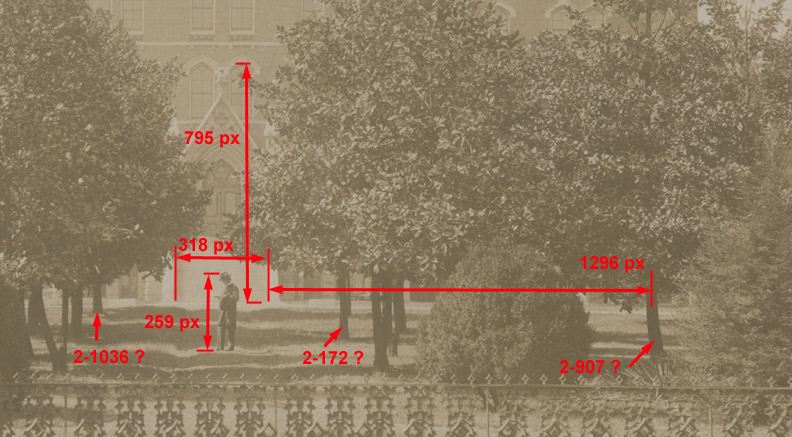
One thing that is immediately apparent is that it will be difficult to establish unambiguously which (if any) of the trees in the pre-1897 photo might be 2-1036 and 2-172, since there are several trees in that photo that are on the approximate tree sight lines in the 2015 image. Based on the position of trees relative to the stairs, I’ve identified possible candidates in the annotated pre-1897 image above. One problem with deciding from among the candidates is that it is difficult to know how far away the trees are from the viewer. That’s where Jordan can help. If Jordan is standing in a position that makes him about the same size as the person in the pre-1897 image, then he is probably at about the same distance from the camera as that person.
To establish the relative scales on the photo, I measured the width of the stairs in pixels. This gives a ratio of pre-1897 pixels to 2015 pixels of 1.47 . The top of the window above the stairs is just barely visible, so I measured the distance from it to the ground and got a pixel ratio of 1.46, which agrees well with the first pixel ration estimate. If we assume that Jordan is the same height as the person in the old photo and in the same position, Jordan should be 259/1.47 = 176 pixels in the 2015 image. However, his actual height in the 2015 image is 144 pixels, which means either that he is shorter than the pre-1897 person, or is too far away from the camera. He is probably a bit too far from the camera, which is also evident from the fact that the line of the base of the stairs crosses at his knees rather than at the waist as it does in the older photo. However, I think that can also partly be explained by the camera being at a higher elevation in the pre-1897 photo. The old wintertime photo shows that the ground was probably elevated by a meter or so in order to make the edge of the pond level. If the ground was graded to slope after the pond was removed, the current position where I was standing would be at a slightly lower elevation than the elevation where the pre-1897 photo was taken. I suspect that perhaps I should have been standing a little closer to Kirkland. For now, let’s assume that Jordan was standing in approximately the right spot.
The diagram above shows the sight lines to the locations of existing trees. The place where Jordan was standing is marked with a red dot. The red X indicates that white ash tree 2-861 is no longer there. One thing that is clear from this diagram is why we don’t see the trunk of magnolia 2-386 in the 2015 photo. Its more narrow trunk is directly behind the larger trunk of 2-172. Because magnolia 2-386 is considerably smaller than the five biggest magnolias present in the area in 2015, I’m not confident that it should be visible in the pre-1897 photo. However, it did appear to be in the 1948 aerial photo and it’s possible that for some reason it just didn’t grow as fast as the other five. Its height of about 17 meters and diameter of 67 cm are both larger than that of magnolia 1-454 (16 m and 62.5 cm), the smallest of the four magnolias on Magnolia Lawn whose pre-1900 planting date was investigated in an earlier blog post. If 2-386 is present in the pre-1897 image, then it would be the tree directly behind 2-172. That tree is at approximately the same distance from the camera as the putative 2-1036, which makes sense based on their current locations (see map above). All three trees (2-386, 2-1036, and 2-172) are behind where Jordan was standing in 2015, and the three possible candidates on the pre-1897 image are all behind the person in that picture.
The possible 2-907 candidate in the pre-1897 image was at a distance between the person and the camera, and 2-907 was at distance between me and Jordan in 2015. That’s good with respect to its vertical position. Is 2-907 in the correct position horizontally? Based on the position of 2-907 in the 2015 image (726 pixels from the right edge of the stairs), we would expect that it should be 726 x 1.47 = 1067 pixels to the right of the stairs on the pre-1897 image. However, in the pre-1897 image, the putative 2-907 is 1296 pixels to the right, which is problematic, since in 2015 it is only about 82% as far to the right as it should be if we’ve matched it to the correct tree in the pre-1897 image. However, the character of the lenses of the two cameras may behave differently as one gets farther from the center of the image. It is also possible that the pond was actually a little closer to Kirkland than I thought, and that I was standing a little too far from the Kirkland steps when I took the 2015 photo. Moving the camera closer to the steps would also make Jordan’s height appear more similar to that of the person in the pre-1897 image and would make 2-907 farther to the right in the 2015 photo.
Unfortunately, it isn’t possible to analyze the position of the triple-trunked magnolia 2-791 because it is obscured by vegetation in the foreground in both photos. However, it is in approximately the correct position to be the leftmost of the row of four magnolias nearest the pond in the pre-1897 photo.
Despite the uncertainty in the analysis, the available photographic evidence supports the contention that some of the magnolia trees shown in the pre-1897 image are the same trees as the largest magnolias present east of Kirkland Hall today.
How big and how old were the trees in the pre-1897 image?
Because there is no precise way to calibrate the pixel size to absolute units, we can’t know exactly the size of the trees in the pre-1897 image. However, we can make an estimate based on the height of the person standing in the image. If we assume that he is about 170 cm tall (5 feet, 7 inches), then there are 1.52 pixels per cm at the person’s distance from the camera. The putative magnolia 2-172 has a diameter of 26 pixels or 17 cm using 1.52 pixels/cm. The putative magnolia 2-907 has a diameter of 40 pixels or 26 cm at the same scale. If we assume that the trees are actually the same diameter and that the differences we see are due only to the differences in the two trees’ distances from the camera, that places their actual diameter somewhere within the range of 17 and 26 cm, since the person that we used to establish the scale is standing at a distance intermediate to the distances of the two trees.
The front row of magnolias have a fairly uniform height of about 1460 pixels, or 9.6 meters using the scale of 1.52 pixels/cm. If we assume that the true diameter of all of the trees was an intermediate value of about 21 cm, then the sizes of the nearer trees would be inflated by about a factor of about 1.2 (i.e. 26 cm/21 cm). So deflating the size of the near row of trees by the same factor puts their height at about 8 meters rather than 9.6 m. If we assume a crown spread of about 700 pixels for the near row of trees and apply the same calculation as was used for their height, their crown spreads would be about 3.8 meters.
Conventional wisdom states that southern magnolias grow 0.3 to 0.6 meters per year. At that rate, these trees would be 13 to 25 years old if their height was 8 meters when the photo was taken. If the photo was taken at the latest possible date (1897), the trees would have sprouted between 1872 and 1884. There are other complicating factors – for instance we don’t know how big the trees were when they were planted. But the 1897 date is conservative and the photo could be older than that. So it seems safe to say that those trees were planted at least by the mid-1880s. This means that the array of magnolias that we see in the pre-1897 image are likely to be part of the original landscaping of Kirkland Hall after it was built in 1875. It also seems safe to conclude that the five or six largest magnolias that we see east of Kirkland (2-1036, 2-172, 2-791, 2-907, 2-1002, and probably 2-386) date from near the beginning of the university and qualify as McTyeire legacy trees.
Summary for people who got bored and skipped the calculations
1. I think the biggest magnolias just east of Kirkland Hall are the same ones that are in the pre-1897 photo.
2. Those trees were probably planted on or before 1885, making them 130 years old or older. This makes them McTyeire legacy trees.
3. In the pre-1897 photo, they were about 8 meters (26 ft.) tall, with crown spreads of about 4 meters (13 ft.), and diameters of about 20 cm (8 in.).
What about the giant white oak 2-161 ?
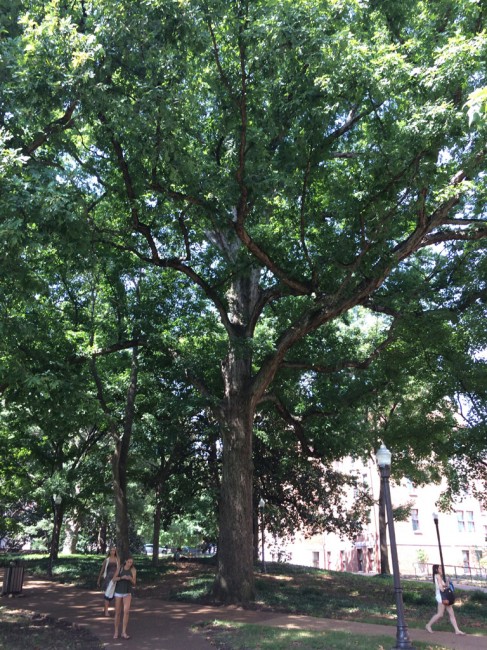
At the start of this post, I promised to mention the beautiful white oak that is very near the location of the former pond that has formed an important part of this story. White oak 2-161 is the largest white oak (Quercus alba) in the arboretum and is the 9th largest tree overall. Its diameter of 117 cm (46 in.) is respectable and its height of 28 m (92 ft.) places it among an elite group of the tallest ten trees on campus. But what really sets this tree apart is its incredible crown spread of 34.5 m (113 ft.). No other tree in the arboretum comes close to matching it. Even the venerable Bicentennial Oak, which is actually wider than it is tall, can’t come close with its 30 m (98 ft.) spread. If it were up to me, I’d nominate white oak 2-161 as Vanderbilt’s official tree mascot, given the use of the white oak leaf and acorn as a symbol of the university.
With a size like this, I have little doubt that this tree is over 100 years old and belongs in the exclusive McTyeire legacy tree club. In size, it is on par with other oaks that have been determined to be among the earliest trees planted on campus, such as the big oaks by the central library and the southern red oak in front of the School of Nursing. Although I don’t (yet) have good aerial photos of this part of campus from the 1920’s, it is apparent from the 1948 photo (above) that this tree was already huge by that time the photo was taken. In comparison, the white ash 2-861, which is known to have been planted around 1910, is much smaller than 2-161 in the photo. The 1948 photo has very clear shadows of many of the trees and I intend at some time in the future to do a careful analysis of these shadows to get more exact measurements of the heights of the trees on the photo. So I may have more to report about the 1948 height of white oak 2-161 in some future post.
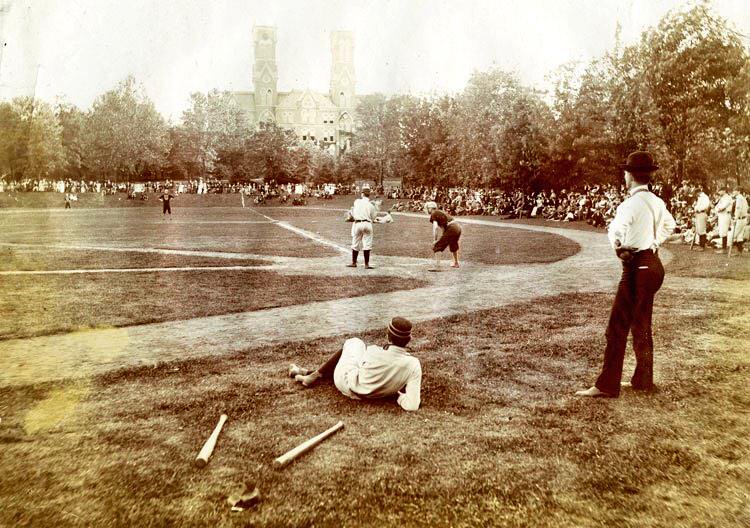
Of course, it would be excellent to be able to spot white oak 2-161 on an old photo to get a better indication of its size at a date earlier than 1948. One photo that has always intrigued me is a famous one of the Vanderbilt vs Cumberland University baseball game in 1892. I first saw it in McGaw’s “The Vanderbilt Campus: A Pictoral History”. The game in this photo was taking place on what was originally called Dudley Field, but later renamed Curry field after the existing football stadium was constructed and the name Dudley Field was transferred to it.
Given the location and direction of the photograph, white oak 2-161 should be visible in the picture. However, this photo presents us with the usual problem when trying to find extant trees in 123 year-old photographs: the tree that is so big and impressive now is MUCH smaller in the old photo, and there are also many other similar-sized trees in the old photo that aren’t around any more. To help us out with this problem, the 1897 map provides some clues about where to look on the old photo:
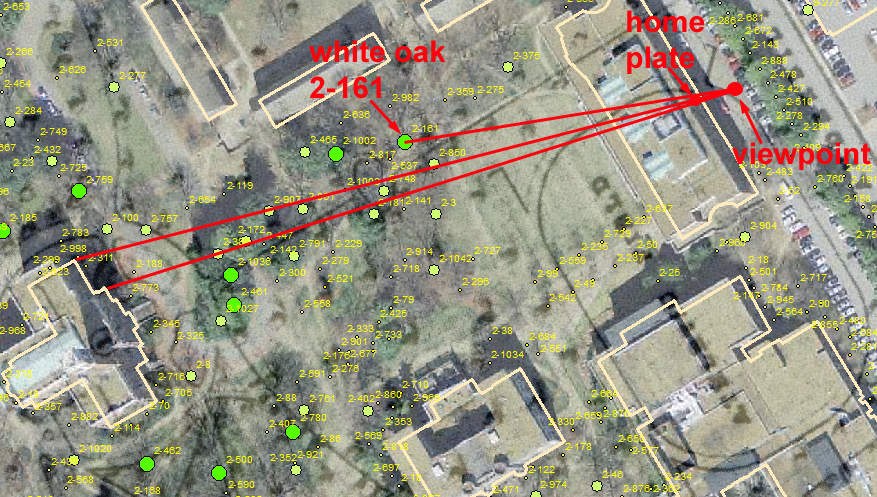
If the 1897 map is accurately georectified, the location of home plate should be right about at the front door of the Law School. The line from the viewpoint to the north tower (which no longer exists) of Kirkland Hall passes through home plate, helping us to place the viewpoint in the Law School parking lot. A line from that viewpoint to the north corner of Kirkland should pass through the pond. White oak 2-161 should be to the right of that on the photo.

Alas, the image doesn’t have sufficient resolution to make out the fence of the pond, and the oak tree isn’t obviously differentiated from the closer vegetation. It’s possible that if I could get a higher-resolution scan, I might be able to make out more, but for now I’ll just have to accept that I can’t recognize white oak 2-161 in the photo.
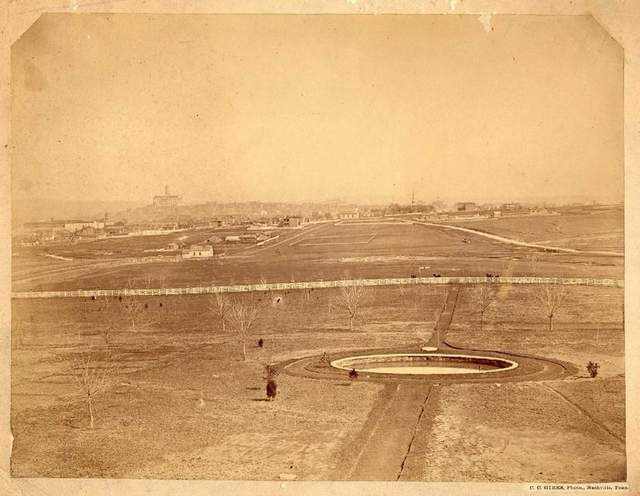
The other image that I’ve found of the area is a much older one, published in a 2006 article from the Tennessean. In that photo from the year that Kirkland Hall was built, we can clearly see the path that leads to the pond and 21st Avenue, but there are no signs of the array of magnolias. So those trees were not among the very first trees planted and must have been planted sometime in the decade or two after Vanderbilt started. It’s possible that the sapling beyond the pond on the left side of the path might be white oak 2-161, but there are too few landmarks to be able to tell for sure, given the uncertainty about the exact location of the pond.
This photo emphasizes clearly that Vanderbilt really was nothing but a cow pasture when it started and that it was pretty far outside of the city. For comparison purposes, I tried to take an image from as close to the exact same spot as possible – from the highest window looking out from the staircase under the Kirkland tower:
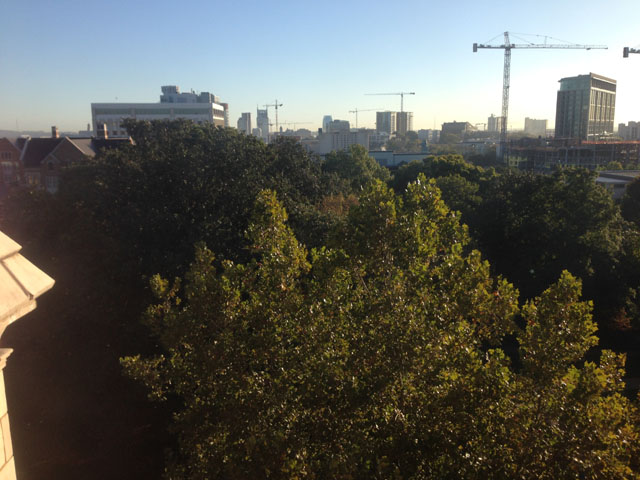
The view has changed so much since 1875 that it is almost unrecognizable as the same place. A sea of trees has replaced the cow pasture, and skyscrapers and cranes fill the skyline of the city. The only feature that is recognizable in both pictures is the state capitol building that is barely visible on the horizon to the left of the Baker Building. How far we have come in 140 years! The trees of Kirkland Hall have witnessed most of this history. If they could speak, what stories could they tell?

Steve Baskauf is a senior lecturer in the Biological Sciences Department at Vanderbilt University. He serves as the communications coordinator for the Vanderbilt Arboretum and can be contacted at steve.baskauf@vanderbilt.edu. Posted 2015 December 20. Unless otherwise noted, the images on this page were photographed by him.
